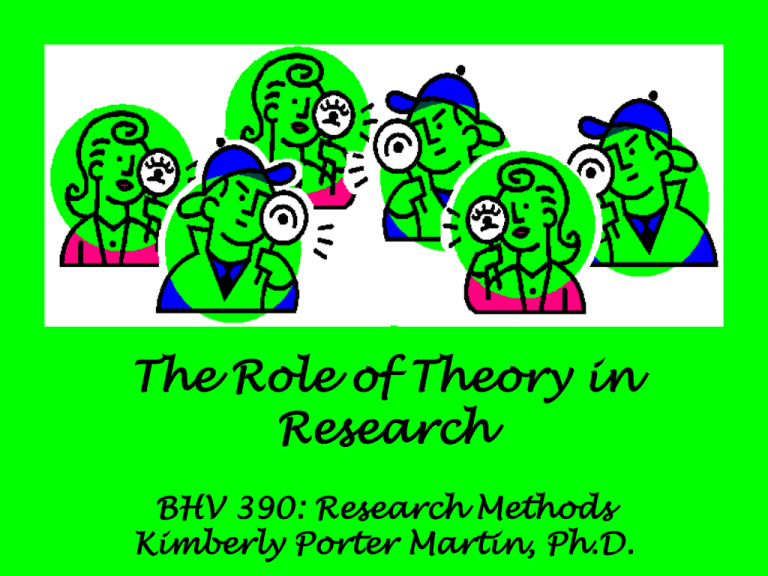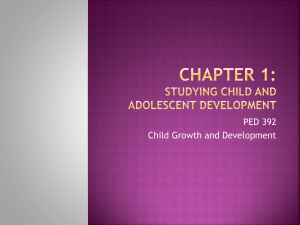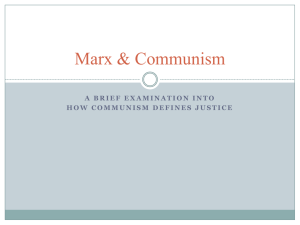
The Role of Theory in
Research
BHV 390: Research Methods
Kimberly Porter Martin, Ph.D.
What is a Theory?
Definition: a set
of related
hypotheses that
provide a better
explanation than
any single
hypothesis.
Each of the following is a kind of
hypothesis:
•
•
•
•
Definitions.
Assumptions.
Proposed explanations.
Logical connections between
definitions, asumptions and
explanations.
If people are talking about any of
these things, they are talking
about theory.
The World of Theories
• Theories can be based on logic, ideas or belief
without the use of empirical evidence
• Grounded theories are derived from empirical
evidence, and are continuously tested against new
empirical evidence
• Many different and sometimes conflicting theories
can coexist and be used for different purposes
• Theories are the basis from which world views are
developed and changed
Examples of Theories
Marx’s Theory
Freud’s Theory
Social Learning Theory
Parental Investment Theory
Some of Marx’s Definitions
• Private property – surplus production
• Capital – the resources needed to
produce surplus
• Social labor – the labor needed to
produce surplus
• Bourgeoisie – those who control capital
• Proletariat – those who provide social
labor
• Capitalism – the system of conflict
between the bourgeoisie and the
proletariat
Logical Connections from Marx
Private property is produced by social labor
using capital.
The bourgeoisie control the capital needed
to produce private property.
The proletariat provide the social labor
needed to produce private property.
The proletariat cannot produce without
capital.
The bourgeoisie and the proletariat fight to
control capital and, therefore, private
property.
Three of Marx’s Assumptions
Social behavior primarily results from
the control and/or manipulation of
economic factors.
The economic systems of all types of
societies work in much the same
way.
Conflict is inherent in social behavior
and organization.
Some of Freud’s Definitions
•
•
•
•
•
Oral Stage – gratification through oral
stimulation 0-2 years
Anal Stage – gratification through control of
bowels 2-3 years
Phallic Stage – conflict over attraction to
opposite sex parent (Oedipal and Electra
Complexes) 3-5 years
Latent Stage – avoidance of opposite sex
peers 5-12 years
Genital Stage – emergence of adult sexuality
in teens 12+ years
Logical Connections from Freud
• The first stage for infants is associated with
eating/drinking.
• The second stage for toddlers is associated
with potty training.
• The third stage is associated with first
awareness of genitalia.
• The fourth stage provides a break from sexual
development for other skills to emerge.
• The fifth stage takes individuals into adult
sexuality.
Freud’s Assumptions
• Children develop in stages
• Each stage deals with a major task that must
be learned at that time in the child’s life.
• Physical pleasure and control are primarily
focused on sexuality.
• Child development is primarily affected by
stages of sexual awareness.
• Stages must be completed successfully for
normal development.
• Problems at a any developmental stage will
result in problems in adult functioning.
Some Parental Investment Theory
(PIT) Definitions
• Parental investment – biological,
economic, social and emotional support
for offspring.
• Differential reproduction – variability in the
number of offspring produced by
individuals.
• Reproductive potential – the maximum
number of offspring possible for an
individual.
• Reproductive success – production of
offspring that survive and reproduce.
Logical Connections from PIT
• Human males only have to make a minimal
parental investment to obtain reproductive success
(a few sperm)
• Female humans must make an enormous parental
investment to obtain reproductive success (+/- 5
years)
• Male humans have reproductive potential limited
only by the number of partners
• Females have limited reproductive potential
because of the investment needed from mothers
• Males and females will have significantly different
mate selection strategies because of differential
parental investment.
Some PIT Assumptions
• Human mate choice is influenced by
inherited characteristics
• Inherited characteristics will reflect the
most successful mating strategies over
time
• Human mate choice is influenced by both
conscious and unconscious factors
• Culture is the learned set of strategies that
help individuals maximize their
reproductive success.
Some Definitions from Bandura’s
Social Learning Theory
• Attention – noticing and being interested
in what others are doing
• Retention – remembering what others do
• Reproduction – copying or modeling
what others do
• Motivation – having the desire to do what
others do
• Reinforcement – rewards and
punishments for doing what others do
Some Logical Connections from SLT
• When the behaviors of others are rewarded or
punished, the behaviors will be noticed.
• When the behaviors of others are rewarded or
punished, the behaviors will be remembered.
• The behaviors of others that are rewarded will
be reproduced
• Individuals will be motivated to reproduce
rewarded behaviors
• Individual will be motivated to avoid punished
behaviors.
Some SLT Assumptions
• Behavior is socially learned.
• Individuals will model the
behaviors of others in their
social environments.
• Individuals will try to
maximize rewards and
minimize punishments for
behaviors.
Powerpoint Study Guide
•
•
•
•
•
Theory
Hypothesis
Definitions
Assumptions
Logical
Connections
• Grounded Theories
•
•
•
•
Marx’s Theory
Freud’s Theory
Social Learning Theory
Parental Investment
Theory








